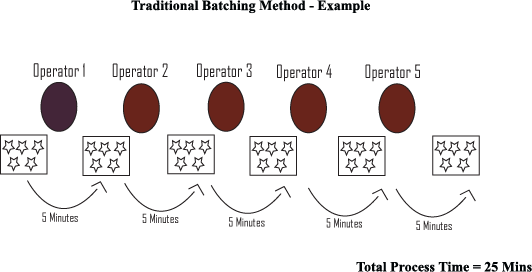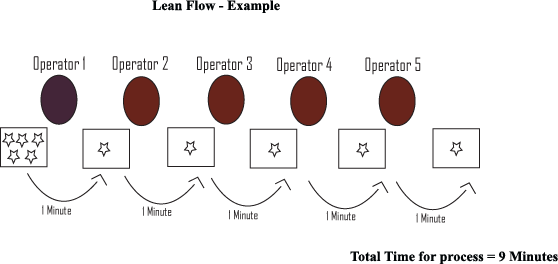Lean Flow is about how items or people we are dealing with in a process move from the first step to the last. Obviously, the intention in Lean flow is to move the item or product through the process as quick as possible, without any risk to quality and customer satisfaction.

In fact, flow is about increasing the throughput of work undertaken in the process, whilst improving quality and customer satisfaction.
This concept, which emanated from the Toyota Production System, can be used in any industry. Any business that has a process can and should use such Flow techniques.
The Benefits
When successfully achieved, expect productivity improvements far greater than 40%.
Through the improvement of one’s productivity will come increased capacity to process more items, and less resource needed to do this. Also, on-time Delivery will improve, and therefore customer satisfaction.
If customer satisfaction improves, and one’s capacity and capability to turn work around quicker also develops, you have just encountered a powerful business improvement tool, which has actively created a competitive advantage for you in your market place!The principles of Lean Flow emphasises that the best way to run a process is to use the minimum resources and time as possible, from start to end, thus seeking to link as much Value Added steps together – Aim to ‘make one and move it on’, as this is the most efficient option.
An Example
The best way to describe Lean Flow is to use an example. The following diagram could be for office paperwork like a data entry process, or for a manufacturing process.
Imagine, in this simplistic example, that for ease of understanding, each operation takes a cycle time of 1 minute. (Cycle time means the amount of time it take the operation to conduct one full process step> E.G – complete one item at a certain stage)
Imagine too, that the batch of 5 items in this process do not move until all operations for that one step have been completed. In this case, person one processes the 5 items in 5 minutes.
She passes the batch on to the next person in the process who takes 5 minutes to complete the batch at operation 2.
This carries on down the process until the fifth and final person completes their operations on all 5 items in 5 minutes.
The total time it took for all 5 items to be completed in the entire process is 25 minutes.

Now, picture Lean flow (or continuous flow as it is called in Manufacturing) in the same scenario, but this time each person processes one and moves it on to the next person straight away.
After the first item has flowed through the complete process, every minute after that, another item will be completed, until all 5 have been processed.
The total time it now takes is 9 minutes! Why, because you have just eliminated some of the the traditional wastes caught up in this process.

The Real World
Naturally, in the real world, there are limitations, like multiple jobs running, a large distance between operations and other constraints, but the principle of Lean flow are the same – remove the waste and make your process more efficient – aim to flow work through the process with as little hold ups as possible.
when I run through the above example, many people believe I have just tricked them, and that the example is not true. “The gains cannot possibly be made and it is easy to run though it on paper, but such gains cannot be met in the real world.”
Interestingly, I have witnessed many companies achieve just these gains, when implementing lean flow! In one such example, I asked a cell, who produced Aerospace fuel pumps, to produce in their normal way. This ‘normal’ way incidentally, was typical batch and queue, where they would build Fuel Pumps in batches of eight. The batch would only move on to Inspection when every part had been assembled.
They agreed to build 4 pumps in the morning in batch and queue method with two operators. In the afternoon, i asked them to build one at a time, and on one condition: they flow one pump through the build process, focusing on keeping the product moving. I also asked them not to rush, but go the same speed as normal………………………….
The Gains
The results – They built 4 pumps in 4.5 hours in the traditional way of working.
The Lean Flow in the afternoon, which focused on make one part and move it on, took 2 hours –that’s a 60% improvement in lead time! Needless to say, when the very people who were sceptical at first, saw the real gains in person, they were sold straight away!
We then set about to incorporate flow into their cell and the result being that they could achieve 40% more output with half the team needed in the process!
Improving Flow
So, how do you implement Lean Flow? Although the following is not meant to be a definitive guide to running a Lean process, you can use the pointers to help develop flow within your processes:
1.Map the process: Follow each step and draw it down on paper. Measure the process as well: What is the process? What are we achieving? What are our process metrics telling us? What do our customers think of us?
2. Identify and note down all the problems that the process owners experience. What do the staff think? What about the managers and other stakeholders? What areas of frustration are there? Do not try to jump the gun here and come up with solutions; just ask for input as to what the issues are.
3.Identify all waste in the current process using the seven wastes as a guide to what should be looked for. For each waste we should ask why it occurs and what could be done to prevent it.
4. Now map an ideal state – create the perfect process that you could achieve if you didn’t have constraints – what it would look like if we had no waste whatsoever -Aim for perfection! You have now created an Ideal State Map – something that probably will not be achieved. Now go back and create the next best process: One which is the best you can do in the real world. Now draw this and include actions on it, in order to achieve this Future State Map. By following this simple formula, it allows people to think differently than they would do if they started with the current state and were then asked to make improvements. – Preconceptions can be challenged easily with this method.
5. Develop an action plan to show actions needed, including timescales and owners to those actions, in order to move from the existing state to the Future improved state. Then commit to the process – Commitment means getting accountability from individuals in the team, conducting regular weekly meetings to show status against the plan and keep working and making improvements to the process according to your action plan. – Stick with it!
6. Ensure that you monitor your new process, by putting performance measures in place to show quantifiable improvements. Make it responsibility of select team members to monitor and review them regularly and again, more importantly, take ownership and accountability for them.
Continue to monitor and make improvements in the effort for continuous improvement and celebrate team successes, no matter how small they seem.
